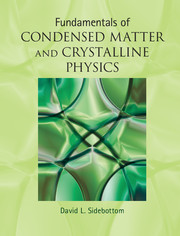 Fundamentals of Condensed Matter and Crystalline Physics
Fundamentals of Condensed Matter and Crystalline Physics from Part III - Dynamics
Published online by Cambridge University Press: 05 August 2012
Introduction
In the previous chapter, we examined the elastic nature of a crystal and replaced the notion of atoms as independent harmonic oscillators with the concept of phonons as quantized pieces of elastic waves propagating within a crystal. In this chapter we bolster our confidence in the reality of these phonons by examining two thermal properties of a crystal: its specific heat and its thermal conductivity. At low temperatures, the specific heat of a crystal decreases as the cube of the temperature. A model (attributed to Einstein) based only on independent harmonic oscillators is unable to account for this particular low temperature dependence, while the Debye model, involving a population of phonons, properly accounts for the temperature dependence. Likewise, the thermal conductivity of a crystal can only be understood using the phonon picture. The thermal conductivity exhibits a sharp division in its temperature dependence between a T 3 variation at low temperatures and a 1/T dependence at high temperatures. This division stems from the nature of phonon–phonon collisions, which are only truly successful in retarding heat flow at high temperatures where so-called Umklapp processes dominate. In these collisions, the resultant phonon emerging from the collision extends beyond the boundaries of the Brillouin zone and suffers strong Bragg scattering by the lattice.
Specific heat of solids
Consider a crystal maintained at some finite temperature. Clearly the crystal contains energy in the form of lattice vibrations for which we have now developed two, self-consistent pictures. In one picture, we view this energy as stored in atoms that act as local harmonic oscillators. In the other picture, the energy is stored in a large population of phonons. The phonons appear in a variety of energies consistent with both the dispersion relation and the restricted set of allowed wave vectors imposed by the finite size of the crystal and the boundary of the first Brillouin zone.
To save this book to your Kindle, first ensure [email protected] is added to your Approved Personal Document E-mail List under your Personal Document Settings on the Manage Your Content and Devices page of your Amazon account. Then enter the ‘name’ part of your Kindle email address below. Find out more about saving to your Kindle.
Note you can select to save to either the @free.kindle.com or @kindle.com variations. ‘@free.kindle.com’ emails are free but can only be saved to your device when it is connected to wi-fi. ‘@kindle.com’ emails can be delivered even when you are not connected to wi-fi, but note that service fees apply.
Find out more about the Kindle Personal Document Service.
To save content items to your account, please confirm that you agree to abide by our usage policies. If this is the first time you use this feature, you will be asked to authorise Cambridge Core to connect with your account. Find out more about saving content to Dropbox.
To save content items to your account, please confirm that you agree to abide by our usage policies. If this is the first time you use this feature, you will be asked to authorise Cambridge Core to connect with your account. Find out more about saving content to Google Drive.